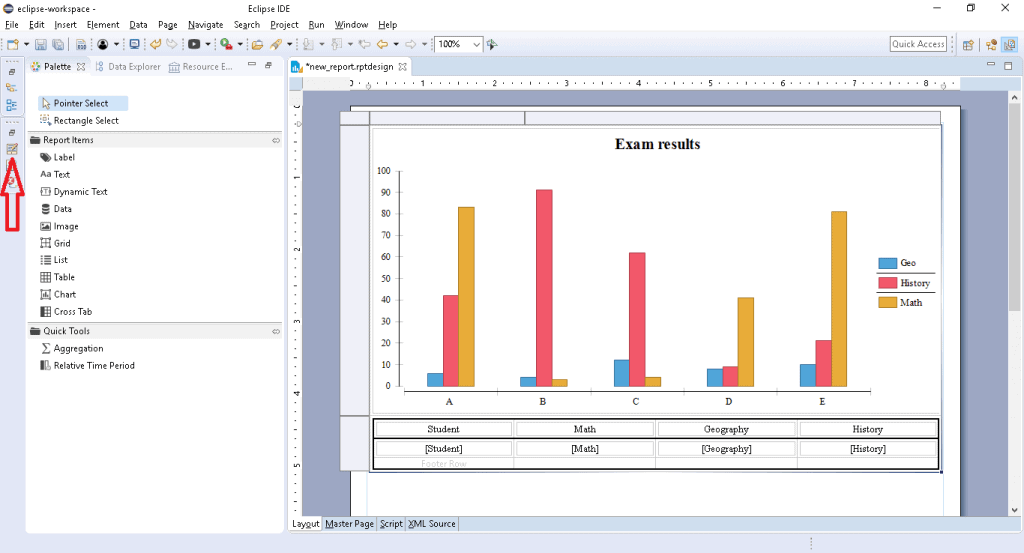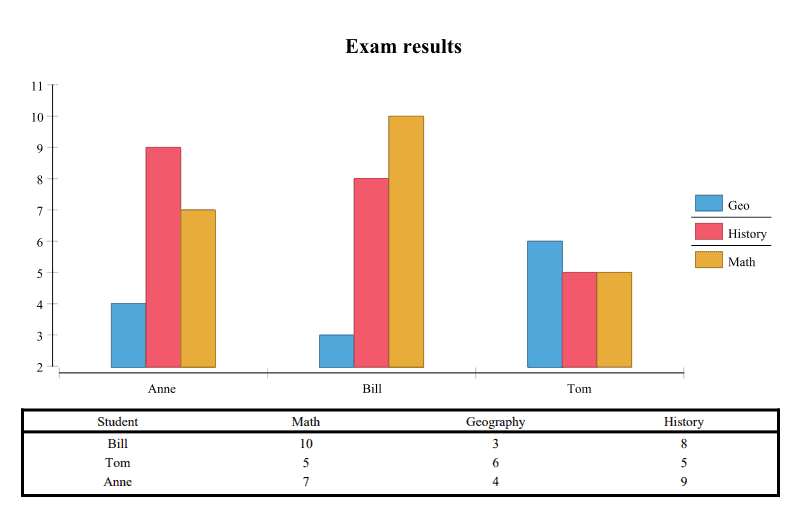1. 简介
在本文中,我们将学习如何将 BIRT(Business Intelligence and Reporting Tools)集成到 Spring Boot MVC 项目中,实现 HTML 与 PDF 格式的静态与动态报表输出。
2. 什么是 BIRT?
BIRT 是一个开源的报表引擎,专为 Java Web 应用设计,支持数据可视化功能。
它是 Eclipse 基金会下的顶级项目,由 IBM 和 Innovent Solutions 共同推动开发,最初由 Actuate 于 2004 年末发起。
该框架支持连接多种数据源,能够灵活地生成各类报表,包括图表、表格等。
3. Maven 依赖配置
BIRT 包含两个核心组件:
✅ 一个是用于创建报表设计文件的可视化报表设计器
✅ 一个是用于解析和渲染报表的运行时组件
我们将在 Spring Boot 项目中同时使用这两个组件。
3.1. 引入 BIRT 框架依赖
官方在 Maven Central 上提供的最新版本是 2016 年的 4.6 版本,但目前 Eclipse 官网已提供更新的 4.8 版本。
虽然可以手动下载并导入依赖库(约 68MB),但更推荐使用由 Innovent Solutions 提供的 Maven 托管版本:
<dependency>
<groupId>com.innoventsolutions.birt.runtime</groupId>
<artifactId>org.eclipse.birt.runtime_4.8.0-20180626</artifactId>
<version>4.8.0</version>
</dependency>
3.2. Spring Boot 相关依赖
⚠️ 注意:BIRT 的 JAR 包中自带了 Slf4J 实现,与 Spring Boot 默认使用的 Logback 冲突,因此需要排除 Logback:
<dependency>
<groupId>org.springframework.boot</groupId>
<artifactId>spring-boot-starter-logging</artifactId>
<exclusions>
<exclusion>
<groupId>ch.qos.logback</groupId>
<artifactId>logback-classic</artifactId>
</exclusion>
</exclusions>
</dependency>
至此,项目环境准备完成。
4. BIRT 报表结构
在 BIRT 中,报表是一个 XML 格式的配置文件,后缀为 .rptdesign,用于定义报表的布局、样式、数据源等信息。
生成一个基础动态报表需要配置以下三个部分:
- 数据源(如 CSV 文件或数据库)
- 显示元素(如表格、图表)
- 页面设计(布局、样式)
BIRT 提供了丰富的内置组件,支持主流数据源、图表、表格等,也可以通过扩展机制自定义组件。
5. Eclipse 报表设计器
为了简化报表设计,Eclipse 提供了图形化插件,支持拖拽操作、组件属性编辑、数据源配置等功能。
设计器界面包括:
- Palette:提供可拖拽的组件
- Property Editor:选中组件后显示其详细配置
- Outline:以树形结构展示整个页面结构
- Data Explorer:管理报表数据源和数据集
如下图所示,展示了设计器界面及数据源配置区域:

设计器中创建的报表文件路径为:<project_root>/reports/csv_data_report.rptdesign
对于已经使用 Eclipse 的开发者,只需安装 BIRT 插件即可。
未使用 Eclipse 的开发者,可下载 Eclipse Report Designer 工具包,内含预装插件的便携版 Eclipse。
6. 编程方式创建报表
除了图形化设计器,也可以通过代码创建报表,但这种方式文档较少,需要深入源码和社区讨论。
例如,以下代码用于创建一个包含图片和文本的静态报表:
DesignElementHandle element = factory.newSimpleMasterPage("Page Master");
design.getMasterPages().add(element);
GridHandle grid = factory.newGridItem(null, 2, 1);
design.getBody().add(grid);
grid.setWidth("100%");
RowHandle row0 = (RowHandle) grid.getRows().get(0);
ImageHandle image = factory.newImage(null);
CellHandle cell = (CellHandle) row0.getCells().get(0);
cell.getContent().add(image);
image.setURL("\"https://www.baeldung.com/wp-content/themes/baeldung/favicon/favicon-96x96.png\"");
LabelHandle label = factory.newLabel(null);
cell = (CellHandle) row0.getCells().get(1);
cell.getContent().add(label);
label.setText("Hello, Baeldung world!");
生成的报表如下图所示:

报表文件路径为:<project_root>/reports/static_report.rptdesign
7. 配置数据源
BIRT 支持多种数据源类型,包括 CSV、数据库、JDBC 等。
7.1. 配置 CSV 数据源
示例中使用的 CSV 文件内容如下:
Student, Math, Geography, History
Bill, 10,3,8
Tom, 5,6,5
Anne, 7, 4,9
配置步骤如下:
- 打开设计器 → 右键点击 Data Sources
- 选择 Flat File Data Source
- 选择文件路径并设置首行为列名
- 测试连接
7.2. 配置数据集
数据源配置完成后,需创建数据集来定义具体显示哪些数据:
- 右键点击 Data Sets
- 选择对应的数据源
- 选择要显示的列
- 设置输出列的数据类型
- 点击 Preview Results 预览数据
7.3. 其他数据源类型
对于 JDBC 数据源,可能需要编写 SQL 查询语句或调用存储过程。
此外,BIRT 还支持将多个数据集合并为一个新数据集。
8. 报表渲染
报表设计完成后,需通过 BIRT 引擎进行渲染,输出 HTML 或 PDF 等格式。
8.1. 初始化引擎
BIRT 的 ReportEngine 类负责解析报表设计并生成最终输出。
⚠️ 注意:创建引擎实例开销较大,应只创建一次并复用:
@PostConstruct
protected void initialize() throws BirtException {
EngineConfig config = new EngineConfig();
config.getAppContext().put("spring", this.context);
Platform.startup(config);
IReportEngineFactory factory = (IReportEngineFactory) Platform
.createFactoryObject(IReportEngineFactory.EXTENSION_REPORT_ENGINE_FACTORY);
birtEngine = factory.createReportEngine(config);
imageFolder = System.getProperty("user.dir") + File.separatorChar + reportsPath + imagesPath;
loadReports();
}
@Override
public void destroy() {
birtEngine.destroy();
Platform.shutdown();
}
8.2. 输出格式配置
BIRT 支持 HTML、PDF、PPT、ODT 等多种格式。以下为 HTML 和 PDF 的渲染示例:
PDF 渲染
private void generatePDFReport(IReportRunnable report, HttpServletResponse response,
HttpServletRequest request) {
IRunAndRenderTask runAndRenderTask = birtEngine.createRunAndRenderTask(report);
response.setContentType(birtEngine.getMIMEType("pdf"));
IRenderOption options = new RenderOption();
PDFRenderOption pdfRenderOption = new PDFRenderOption(options);
pdfRenderOption.setOutputFormat("pdf");
runAndRenderTask.setRenderOption(pdfRenderOption);
runAndRenderTask.getAppContext().put(EngineConstants.APPCONTEXT_PDF_RENDER_CONTEXT, request);
try {
pdfRenderOption.setOutputStream(response.getOutputStream());
runAndRenderTask.run();
} catch (Exception e) {
throw new RuntimeException(e.getMessage(), e);
} finally {
runAndRenderTask.close();
}
}
HTML 渲染
private void generateHTMLReport(IReportRunnable report, HttpServletResponse response,
HttpServletRequest request) {
IRunAndRenderTask runAndRenderTask = birtEngine.createRunAndRenderTask(report);
response.setContentType(birtEngine.getMIMEType("html"));
IRenderOption options = new RenderOption();
HTMLRenderOption htmlOptions = new HTMLRenderOption(options);
htmlOptions.setOutputFormat("html");
htmlOptions.setBaseImageURL("/" + reportsPath + imagesPath);
htmlOptions.setImageDirectory(imageFolder);
htmlOptions.setImageHandler(htmlImageHandler);
runAndRenderTask.setRenderOption(htmlOptions);
runAndRenderTask.getAppContext().put(
EngineConstants.APPCONTEXT_BIRT_VIEWER_HTTPSERVET_REQUEST, request);
try {
htmlOptions.setOutputStream(response.getOutputStream());
runAndRenderTask.run();
} catch (Exception e) {
throw new RuntimeException(e.getMessage(), e);
} finally {
runAndRenderTask.close();
}
}
⚠️ 注意:HTML 渲染需设置图片路径与处理器,推荐使用 HTMLServerImageHandler,避免因路径问题导致图片无法加载。
8.3. 图片资源发布
HTML 报表中图片为外部资源,需确保其在服务器路径下可访问。
我们在 Spring Boot 中配置资源处理器:
@SpringBootApplication
@EnableWebMvc
public class ReportEngineApplication implements WebMvcConfigurer {
@Value("${reports.relative.path}")
private String reportsPath;
@Value("${images.relative.path}")
private String imagesPath;
@Override
public void addResourceHandlers(ResourceHandlerRegistry registry) {
registry
.addResourceHandler(reportsPath + imagesPath + "/**")
.addResourceLocations("file:///" + System.getProperty("user.dir") + "/"
+ reportsPath + imagesPath);
}
}
9. 控制器配置
最后,我们编写一个控制器用于接收请求并返回报表结果:
@RequestMapping(method = RequestMethod.GET, value = "/report/{name}")
@ResponseBody
public void generateFullReport(HttpServletResponse response, HttpServletRequest request,
@PathVariable("name") String name, @RequestParam("output") String output)
throws EngineException, IOException {
OutputType format = OutputType.from(output);
reportService.generateMainReport(name, format, response, request);
}
用户可通过 URL 参数 output 指定输出格式,如:
/report/csv_data_report?output=pdf/report/csv_data_report?output=html/report/static_report?output=pdf/report/static_report?output=html
报表效果如下图所示:

刷新报表只需访问:/report/reload
10. 小结
本文演示了如何将 BIRT 集成到 Spring Boot 应用中,涵盖了依赖配置、报表设计、数据源配置、渲染逻辑及图片处理等关键步骤。
虽然 BIRT 学习曲线较陡,但其灵活性和功能强大,非常适合作为企业级报表解决方案。
完整源码可访问:GitHub 项目地址